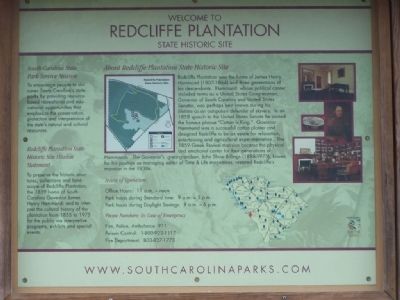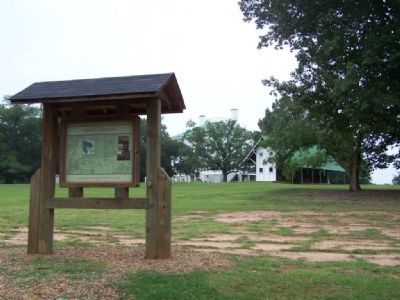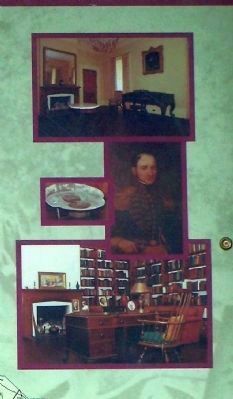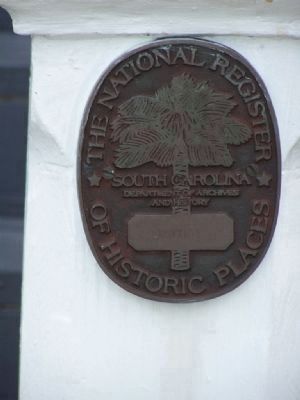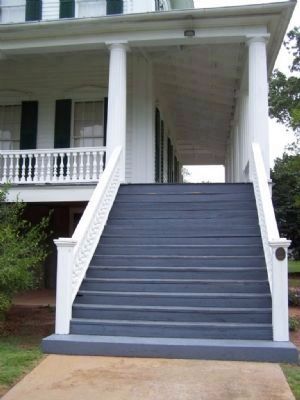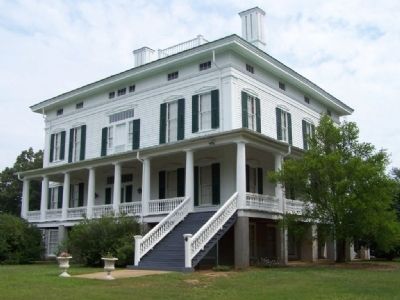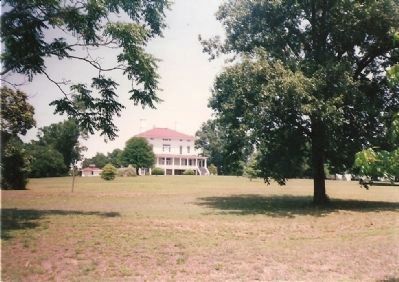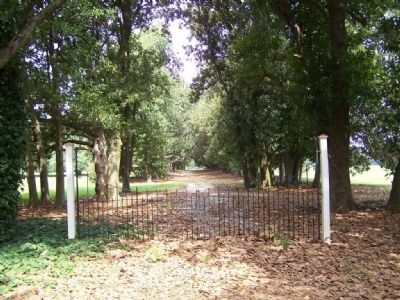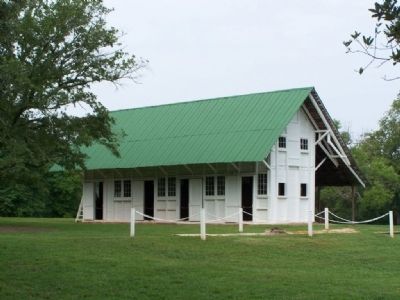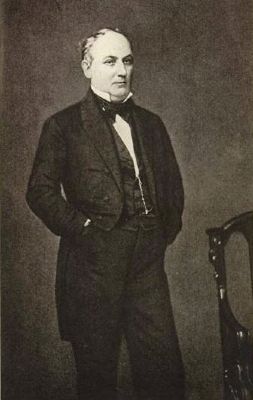Beech Island in Aiken County, South Carolina — The American South (South Atlantic)
Redcliffe Plantation
State Historic Site
About Redcliffe Plantation State Historic Site
Redcliffe Plantation was the home of James Henry Hammond (1807-1864) and three generations of his descendants. Hammond whose political career included terms as a United States Congressman, Governor of South Carolina and United States Senator, was perhaps best known during his lifetime as an outspoken defender of slavery. In an 1858 speech to the United States senate he coined the famous phrase "Cotton is King." Governor Hammond was a successful cotton planter and designed Redcliffe to be an estate for relaxation, entertaining and agricultural experimentation. The 1859 Greek revival mansion became the physical and emotional center for four generations of Hammonds. The Governor's great-grandson. John Shaw Billings (1898-1975), known for his position as managing editor of Time & Life magazines, restored Redcliffe's mansion in the 1930s.
South Carolina State Park Service Mission
To encourage people to discover South Carolina's state parks by providing resource-based recreational and educational opportunities that emphasize the conservation, protection and interpretation of the state's natural and cultural resources.
Redcliffe Plantation State Historic Site Mission Statement
To preserve the historic structures, collections and landscape of Redcliffe Plantation, the 1959 home of South Carolina Governor James Henry Hammond; and to interpret the cultural history of the plantation from 1855 to 1975 for the public via interpretive programs, exhibits and special events.
Erected by South Carolina State Park Service.
Topics. This historical marker is listed in these topic lists: Agriculture • Architecture. A significant historical year for this entry is 1858.
Location. 33° 24.921′ N, 81° 51.953′ W. Marker is on Beech Island, South Carolina, in Aiken County. Marker is on Redcliffe Road. Follow Hammond Road and signs to the parking lot. Touch for map. Marker is at or near this postal address: 181 Redcliffe Rd, Beech Island SC 29842, United States of America. Touch for directions.
Other nearby markers. At least 10 other markers are within 6 miles of this marker, measured as the crow flies. Historic Church (approx. 0.6 miles away); Downer Institute & School / Downer School, 19241986 (approx. 0.6 miles away); Beech Island Baptist Church (approx. one mile away); Silver Bluff Baptist Church (approx. 1½ miles away); Savannah Town / Fort Moore (approx. 3 miles away); Signal Corps Aviation School (approx. 5½ miles away in Georgia); Jefferson High School / Rev. Austin Jefferson, Sr. (approx. 5.7 miles away); Storm Branch Baptist Church (approx. 5.7 miles away); Jacksonville School / Jacksonville Lodge (approx. 6 miles away); Home of Governor Telfair (approx. 6 miles away in Georgia). Touch for a list and map of all markers in Beech Island.
Regarding Redcliffe Plantation. Current status – In 1973 the property was deeded to the South Carolina Department of Parks, Recreation, and Tourism. It is open to the public.
Timeline:
1857 – Construction of house began – supervised by Hammond's sons.
1859 – House completed.
1886 – Hammond's son Harry removed the porches and replaced them with a one-story, 12-foot wide L-shaped porch that extended along the south and east sides of the house. The stairway was placed at the eastern end of the south porch.
1930 – House restored by John Shaw Billings.
1973 – Property donated to the state.
************
National Register of Historic Places:
Redcliffe ** (added 1973 - Building - #73001671)
Historic Significance: Event, Architecture/Engineering, Person
Architect, builder, or engineer: Berckman,Louis
Architectural Style: Greek Revival
Historic Person: Hammomd,James,Henry,et al.
Significant Year: 1973, 1857
Area of Significance: Social History, Agriculture, Conservation, Literature, Architecture, Landscape Architecture
Period of Significance: 1875-1899, 1950-1974
Owner: Private
Historic Function: Agriculture/Subsistence, Domestic
Historic Sub-function: Agricultural Outbuildings, Single Dwelling
Current Function: Domestic
Current Sub-function: Single Dwelling
Also see . . .
1. James Henry Hammond. James Henry Hammond (November 15, 1807 – November 13, 1864) was a politician from South Carolina. (Submitted on July 26, 2008, by Mike Stroud of Bluffton, South Carolina.)
2. Redcliffe. Redcliffe is representative of the architectural styles in the South during the early nineteenth century. (Submitted on March 15, 2009, by Brian Scott of Anderson, South Carolina.)
3. Redcliffe Plantation – Beech Island – Aiken County. (Submitted on March 15, 2009, by Brian Scott of Anderson, South Carolina.)
4. Redcliffe State Park. Redcliffe Plantation State Historic Site is a state park in South Carolina, USA. (Submitted on March 15, 2009, by Brian Scott of Anderson, South Carolina.)
5. The Hammonds of Redcliffe by Carol K. Rothrock Bleser. Book preview. (Submitted on January 9, 2011, by Brian Scott of Anderson, South Carolina.)
6. John Shaw Billings Photograph Albums, 1875-1939. The series of
photograph albums document the time that John Shaw Billings (1898-1975) and his extended family spent at the Redcliffe plantation in Aiken County, South Carolina. (Submitted on January 9, 2011, by Brian Scott of Anderson, South Carolina.)
Additional commentary.
1. James H. Hammond
As a congressman before his election as governor, James Hammond had made headlines by advocating the death penalty for abolitionists to keep their ideas out of the state and away from slaves.
Hammond theorized that slavery was appropriate for blacks because, among other reasons, it controlled their otherwise untamed carnal instincts, an irony in light of his own inclinations. He had sex with his wife, his wife's sister's four young daughters, his slave mistress sally Johnson, her twelve-year-old daughter Louisa, at least two white men according to historian Martin Duberman, and perhaps other women and male slaves. Nevertheless he was a stern moralist toward his slaves. If a slave couple wanted to divorce they had to convince him that sufficient cause existed; even then, each got a hundred lashes and could not marry for three years...His reputation for cruelty lasted more than a century in the black community. (Source: Lies Across America by James W. Loewen, pg 249-251.)
— Submitted March 15, 2009, by Brian Scott of Anderson, South Carolina.
2. Redcliffe
Redcliffe, begun in 1857 by James Henry Hammond, is a two-story house of wooden construction. Originally, the house stood nine feet above the ground. Double decked porches were built on all four sides. Only the front and back porches had steps down to the ground. Large French windows in all rooms opened onto the porches, upper and lower. n enclosed cupola or observatory, consisting almost entirely of windows, was built on the roof between the two chimneys. Each floor consisted of one central hall with two rooms on either side. The flooring was done in heart pine. Local sycamore trees furnished the wood for the doors, mantels, and banisters. Bookcases of sycamore were made for the library by a German craftsman.
The first major change came immediately after the Hammond family moved into the house. Chilling winds swept through the open space under the house. To control the chill factor, the under area was bricked around the nine feet walls. Later the basement was partitioned off with brick walls into four rooms to match the other floors. Brick soon replaced with sand floors.
In 1886, another major change altered the appearance of Redcliffe. The flat open porches
had been damaged greatly, due to the lack of proper drainage. Harry Hammond, son of the builder, removed the upper porches bringing the main steps down from the corner of the new single piazza. This charge marred the classic symmetry of the house. In July 1901, the observatory on the roof was removed as a fire hazard. A widow's walk replaced the former cupola.
A young landscape architect, Louis Berckman, from Belgium, planned the grounds at Redcliffe. An avenue of magnolia grandiflora was planted. The open fields near the house were used for scientific experiments with vineyards and fruit trees.
Significance
Redcliffe is representative of the architectural style in the South during the early nineteenth century. Built on brick pillars like many of the Lowcountry houses, Redcliffe maintained the pattern of a central hall with four rooms, so characteristic of the Carolina Upcountry. Originally Georgian in style, the house now features many Greek Revival elements. Two slave quarters remain, illustrating the pattern of life prior to the War Between the States.
The builder of Redcliffe, James Henry Hammond, was born on November 15, 1807, at Stony Battery, Newberry District in South Carolina. In 1825, he graduated from the South Carolina College. After reading law in Columbia, South Carolina and Augusta, Georgia, he was admitted to the bar in 1828. He was elected to the United States Congress in 1834, several years after his marriage to Catherine Fitzsimons. Hammond was elected Governor of South Carolina in 1842. During his first two terms as Governor, he secured the transformation of the arsenal at Columbia and the Citadel into military academies. He became a United States Senator in 1857. In the troubled days before the War Between the States, Hammond realized the importance of cotton to the agricultural South. "Cotton is King" he declared in the Senate chambers. Hammond was greatly interested in the improvements of farming methods. In the 1840s he promoted the use of marl. Ahead of his time in social awareness, he provided hospital care for his workers and gave nursery care to the children of working mothers. In December 1855, he was interested in the organization of the Beech Island Agricultural Society. Due to his interest in agriculture, he was visited by Richard Lamb Allen, who in 1842 founded the American Agriculturalist.
The present owner of Redcliffe is John Shaw Billings, a descendant of Hammond. Educated at Harvard, Billings later went to Time, then Maneging Editor of Life. At one time, Billings was called the editorial prime minister of Time/Life, Inc. An important figure in American journalism, John Shaw Billings had a front seat in American history. (Source: National Register nomination
form.)
— Submitted January 9, 2011, by Brian Scott of Anderson, South Carolina.
Credits. This page was last revised on October 13, 2020. It was originally submitted on July 26, 2008, by Mike Stroud of Bluffton, South Carolina. This page has been viewed 4,634 times since then and 61 times this year. Photos: 1. submitted on July 26, 2008, by Mike Stroud of Bluffton, South Carolina. 2. submitted on July 27, 2008, by Mike Stroud of Bluffton, South Carolina. 3, 4, 5, 6. submitted on July 26, 2008, by Mike Stroud of Bluffton, South Carolina. 7. submitted on August 3, 2008, by Craig Swain of Leesburg, Virginia. 8, 9. submitted on July 26, 2008, by Mike Stroud of Bluffton, South Carolina. 10. submitted on March 15, 2009, by Brian Scott of Anderson, South Carolina. • Kevin W. was the editor who published this page.
